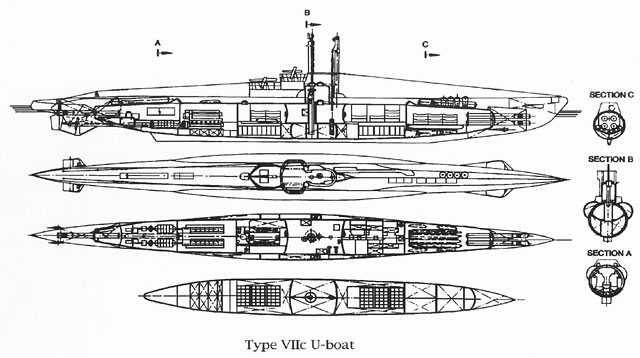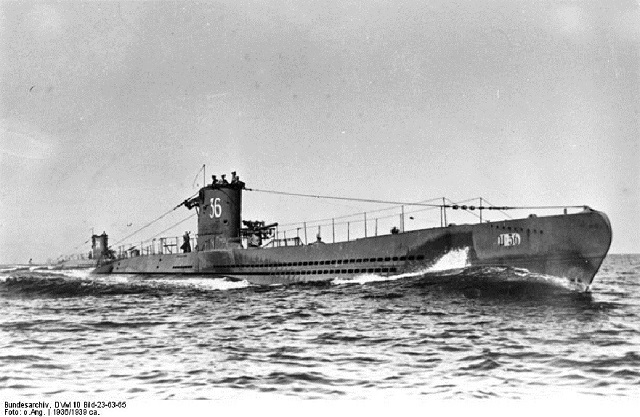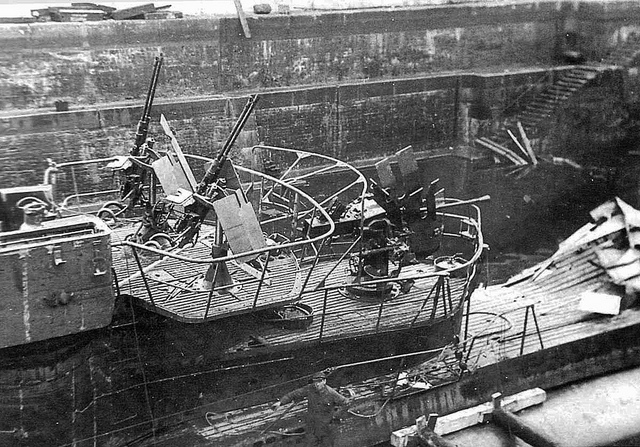History
The type VII submarines were the backbone of the German U-boat fleet. With over 700 units built, this class was not only the most built variant of the German submarines, it is also the most built submarine of all time. The type VII U-boat operated everywhere - in the Atlantic Ocean, the North, Baltic, and Mediterranean Seas and even the Arctic. To fulfil this role, the type VII had 6 sub-types: VII A,B,C,C/41,D and F. This led to great versatility - laying mines, attacking convoys and transporting supplies were all possible. A great influence was the Vetehinen-class, which was built by German engineers in Finland and the German type UB III from 1918. The requirements for this type were high: cheap and fast to build, yet strong, durable, with good manoeuvrability & great range. Although it had poor living conditions for the crew, it was a well-balanced submarine, one that should not be taken lightly. Many people think of the type VII when they talk about WW2 submarines - it became the face of the U-boats and has a legendary status. You can see its greatest achievements here (Note: only military ships):
| U-boat | Date | Ship Type Sunk | Name of ship |
| U 29 | 17. Sept. 1939 | Aircraft Carrier | Courageous |
| U 47 | 14. Oct. 1939 | Battleship | Royal Oak |
| U 81 | 14. Nov. 1941 | Aircraft Carrier | Ark Royal |
| U 331 | 25. Nov. 1941 | Battleship | Barham |
| U 557 | 14. Dec. 1941 | Cruiser | Galatea |
| U 751 | 21. Dec. 1941 | Escort Carrier | Audacity |
| U 565 | 11. March 1942 | Cruiser | Naiad |
| U 73 | 11. Aug. 1942 | Aircraft Carrier | Eagle |
| U 617 | 1. Febr. 1943 | Mine Laying Cruiser | Welshman |
| U 410 | 18. Febr. 1944 | Cruiser | Penelope |
The Type VII was the class that suffered the highest losses. The number of losses increased greatly when the allied anti-submarine technology advanced. Many of them were sunk by their own crews at the end of the war and the remaining U-boats were handed over to the Allied forces. Nonetheless, the type VII was one of the most successful submarine types ever built and still has a high reputation today. U 48, the most successful submarine of WW2, was a type VII U-boat.
Technology
The type VII U-boat is a submarine with one hull and had ballast tanks on the outside. Later versions (VIIC) had an armored hull 22mm thich which was fully welded. A special thing is that the depth rudders couldn't be folded down. All variants were based on a basic type, but they differed in their performance and functions. Armament like the cannon or AA were changed over the years as an answer to the new Allied strategies and technology. Since 1943 all units were equipped with a snorkel, which was a huge improvement. The U-boats could now charge their batteries while being submerged and therefore, had greater chances of survival since they could avoid being spotted by aircraft while charging.

The plans of the type VIIC submarine.
Type VIIA
The first VIIA U-boat, U 27, was launched on 24th June 1936. It was designed to be an an allrounder and it actually didn't have a special ability, it was just the well-balanced design which led to success. The VIIA was the first type to have a torpedo tube in the rear. Also, with its low displacement it was not a problem for the Anglo-German naval agreement and could be massproduced.

As a type VIIA U-boat, U 36 was one of the first VII submarines. This picture was taken before the beginning of the war. When the war started, the numbers were removed from the conning towers.
Type VIIB/VIIC
VIIB was launched two years after the VIIA and had improved diesel engines as well as greater fuel capacity. It was slightly bigger than its predecessor. The torpedo tube in the rear was moved to a special room in the hull. U 69 was the first VIIC submarine and was lauched on 18th April 1940. Type VIIC was an armored version of VIIB and could submerged a few seconds faster.
Type VIID
A minelayer version with a special section behind the conning tower in which the mines were stored. This increased the length to about 77 meter. Greater fuel capacities led to a greater range. VIID entered service in 1941, but only 6 units were built because the other types could already lay mines with their torpedo tubes.

A late-war VII in the shipyard with the typical Flak-emplacements. Note the hull damage behind the conning tower.
Type VIIF
This variant of supply U-boats only had 4 units built. All submarines entered service in 1943 and had bigger torpedo depots. They were designed to supply other U-boats in the sea with torpedoes, but they only transported torpedoes to the submarine bases since the supplying in the ocean made both the supplied U-boat and the VIIF vulnerable.
Data
- crew: 44
- shipyard: Deschimag AG Weser, Bremen; Krupp Germaniawerft, Kiel; Blohm & Voß, Hamburg
- displacement: 626 ts (VIIA) to 1084 ts (VIIF) surfaced, 745 ts to 1181 ts submerged
- length: 66m (VIIA,B,C); 76,9m (VIID); 77,6m (VIIF)
- width: 6m (VIIA,B,C); 6,38m (VIID); 7,30m (VIIF)
- depth: 4,4m (VIIA); 6,2m (VIIB,C); 5m (VIID); 4,9m (VIIF)
- maximal depht: 150m (VIIA,B,D,F); 150-180m (VIIC)
- fuel: 67 ts (VIIA); 108ts (VIIB); 114 ts (VIIC); 169 ts (VIID); 199 ts (VIIF)
- fastest submerging: 30 seconds (VIIA,B,D); 25-30 seconds (VIIC); 35 seconds (VIIF)
- engine: 2 Diesel engines; 2 E-Motors
- engine performance: 2310 hp (VIIA) - 3200 hp (VIIF) surfaced, 750 hp submerged (all)
- speed: 17 knots (VIIA); 18 knots (VIIB); 17,5 knots (VIIC,F); 16,7 knots (VIID)
- range: 6200sm(A);8700sm(B);8500sm(C);11000-14000sm(D,F) surfaced, 90-130sm subm.
- armament: 4 torpedo tubes (bow), 1 (rear) (533mm); multiple AAs; 1 x 88mm cannon
Note:
ts = english "long ton" (1,016 kg), I used it here because it is common in every navy
sm = sea mile
hp = horse power
Thank you for reading and I hope you will read the next episode too!












 cblanco ★
cblanco ★  보드카 중대
보드카 중대  VonManteuffel
VonManteuffel  Heartless Jäger
Heartless Jäger 